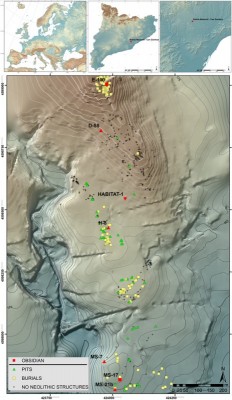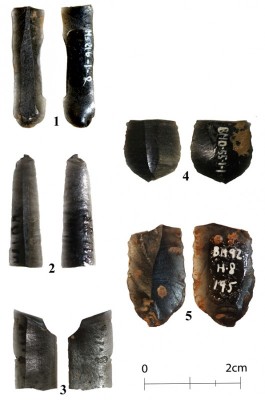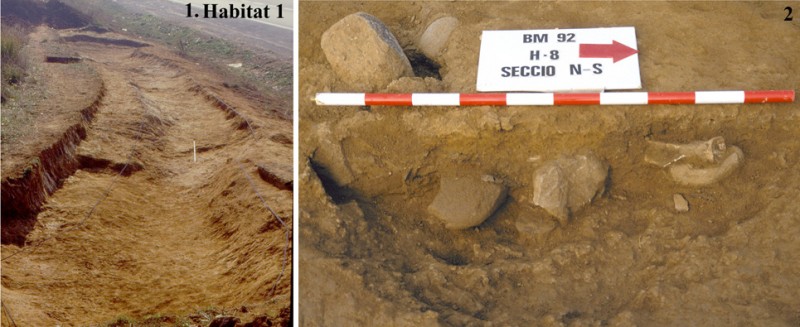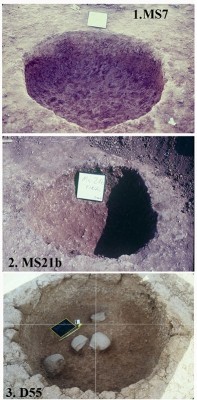New finds of obsidian blades at Neolithic sites in north-eastern Iberia
Context
A recent study of obsidian artefacts found at Neolithic sites in the Iberian Peninsula has demonstrated that this obsidian was sourced from Flow A at Monte Arci, Sardinia, Italy (Terradas et al. 2014). These artefacts were deposited and discovered over 1300km from the source of the raw material—the greatest distance yet known for the distribution of Sardinian obsidian. This evidence further corroborates the existence of a vast exchange network of raw materials and objects across a large part of Western Europe during the late fifth and early fourth millennia BC.
The six obsidian artefacts presented in this study are a bladelet core (Bòbila Padró), a blade (Gavà Mines), and four bladelets (two from Bòbila Madurell and one each from Can Gambús and La Serreta), all knapped using the pressure technique. These objects were deposited as grave goods in individual tombs located within a very restricted geographical area, less than 30km from Barcelona.
New finds
Bòbila Madurell-Can Gambús (Sant Quirze del Vallès, Barcelona) is a 30ha open-air site that has been excavated on numerous occasions during the twentieth century (Figures 1 & 2). The Neolithic structures uncovered include some 80 silos or pits full of waste material, as well as around 175 graves (Llongueras et al. 1981; Martín et al. 1988; Alaminos et al. 1991; Bordas et al. 1993), all attributed to the middle Neolithic (c. 4500–3500 cal BC, in the regional sequence). During 2012 and 2013 we re-examined the materials from the Bòbila Madurell-Can Gambús site, now curated at the Sabadell History Museum, the Catalonian Museum of Archaeology in Barcelona and CEPAP (Centre d’Estudis del Patrimoni Arqueològic de la Prehistòria) at the Autonomous University of Barcelona. This review successfully identified five previously unknown obsidian pieces, in the form of fragments of blade products all knapped using the pressure technique (Figure 3).
These objects were found in the following contexts:
- ‘Habitation’ 1. Though previously considered to be a domestic structure, this feature is actually a 20m-long ditch of unknown function. The fill contained numerous potsherds (including Chassey pottery) and lithic tools, with drills and geometric microliths, as well as evidence of bone tools and ornaments (Figure 4.1).
- Structure H8 (Madurell-Mas Duran Sector): a circular pit with abundant potsherds, faunal remains and blade products. Above all, it yielded much evidence for bone tools and ornaments (including shells and fragments of wild boar tusks) (Figure 4.2).
- Structure BMD55 (Madurell-Can Feu Sector): a circular pit with a double truncated cone cross-section. It contained numerous potsherds and faunal remains, as well as knapped lithic artefacts, malacological remains and bone awls, together with 26 loose teeth from an adult human (Figure 5.3).
- Structure MS7 (Madurell South Sector): a cylindrical pit containing potsherds, lithics and faunal remains, as well as some bone awls and marine shells, some of them pierced (Figure 5.1).
- Structure MS21b (Madurell South Sector): an oval-shaped pit with concave walls from which potsherds, lithic tools and faunal remains were recovered, together with grinding implements and bone tools, including a possible needle (Figure 5.2).
Discussion
Although only five obsidian artefacts have been newly documented, these discoveries have almost doubled the number known to date. The importance of the Bòbila Madurell-Can Gambús site should be stressed—fully seven of the eleven obsidian tools recorded in north-eastern Iberia have been discovered there. Unlike the previous finds, however, which were all discovered in graves, the new objects come from structures associated with domestic contexts. This suggests that obsidian was not acquired exclusively as elaborated products, ready to be deposited as grave good elements. This way, it is possible to infer the arrival of the raw material as already shaped-out cores, as well as the knapping of bladelets in settlements. Some of the remains were used in subsistence activities and later discarded in pits, without being incorporated into funerary assemblages. These data would confirm the existence of certain places where a manufacture of blade products would be carried out and later redistributed over long distances.
The new finds are now being subjected to analytical procedures in order to determine their origin and identify whether they all come from a single source. These results should be compared to those obtained from the distribution of Bedoulian flint originating in Provence, as both of these materials probably were moved together over a wide area throughout the Mediterranean continental coast.
Acknowledgements
This study was carried out in the framework of the research project ‘Approach to the first Neolithic communities in north-east Iberia through funerary practices (HAR2011-23149)’. We would like to thank the Sabadell History Museum and the Catalonian Museum of Archaeology in Barcelona for kindly allowing us to consult the collections from the Bòbila Madurell site studied here, as well as Lluís Sant (Archaeology and Palaeontology Service of the Catalonian Government) for providing the plans of the site.
References
- ALAMINOS, A., R.M. BLANCH & P. LÁZARO. 1991. Bòbila Madurell. Su contribución al Neolítico medio en Cataluña. Revista de Arqueología 128: 14–23.
- BORDAS, A., J. DIAZ, R. POU, A. PARPAL & A. MARTIN. 1993. Excavacions arqueològiques 1991–1992 a la Bòbila Madurell-Mas Duran (Sant Quirze del Vallès, Vallès Occidental). Tribuna d’Arqueologia 1991–1992: 31–47.
- LLONGUERAS, M., R. MARCET & M.A. PETIT. 1981. Excavacions de jaciments neolítics a la Bòbila Madurell (Sant Quirze del Vallès, Barcelona), in Taula Rodona de Montserrat (ed.) El Neolític a Catalunya: 173–83. Montserrat: Publicacions de l’Abadia de Montserrat.
- MARTÍN, A., J. MIRET, J. BOSCH, R.M. BLANCH, S. ALIAGA, R. ENRICH, S. COLOMER, S. ALBIZURI, J. FOLCH, J. MARTÍNEZ & T. CASAS. 1988. Les excavacions al paratge de la Bòbila Madurell i de Can Feu (Sant Quirze del Vallès, Vallès Occidental). Tribuna d’Arqueologia 1987–1988: 77–92.
- TERRADAS, X., B. GRATUZE, J. BOSCH, R. ENRICH, X. ESTEVE, X. OMS & X. RIBÉ. 2014. Neolithic diffusion of obsidian in the western Mediterranean: new data from Iberia. Journal of Archaeological Science 41: 69–78. http://dx.doi.org/10.1016/j.jas.2013.07.023
Authors
- Juan F. Gibaja
Arqueologia i Antropologia, Institució Milà i Fontanals (CSIC-IMF), C/ Egipcíaques 15, Barcelona 08001, Spain - Paloma González
Departament de Prehistòria, Universidad Autònoma de Barcelona, Plaça Cívica, Campus de la UAB, Bellaterra, Barcelona 08193, Spain - Araceli Martín
Departament de Cultura, Generalitat de Catalunya, Portaferrisa 1, Barcelona 08002, Spain - Antoni Palomo
Departament de Prehistòria, Universidad Autònoma de Barcelona, Plaça Cívica, Campus de la UAB, Bellaterra, Barcelona 08193, Spain - M. Àngels Petit
Departament de Prehistòria, Universidad de Barcelona, Montalegre 6, Barcelona 08001, Spain - Xavier Plasencia
Departament de Prehistòria, Universidad Autònoma de Barcelona, Plaça Cívica, Campus de la UAB, Bellaterra, Barcelona 08193, Spain - Gerard Remolins
Regirarocs, S.L., Av. Carlemany 115, Les Escaldes-Engordany, AD700, Andorra - Xavier Terradas
Arqueologia i Antropologia, Institució Milà i Fontanals (CSIC-IMF), C/ Egipcíaques 15, Barcelona 08001, Spain






 Cite this article
Cite this article